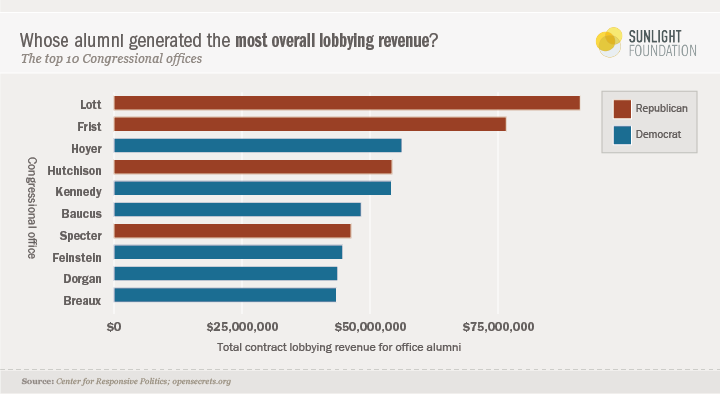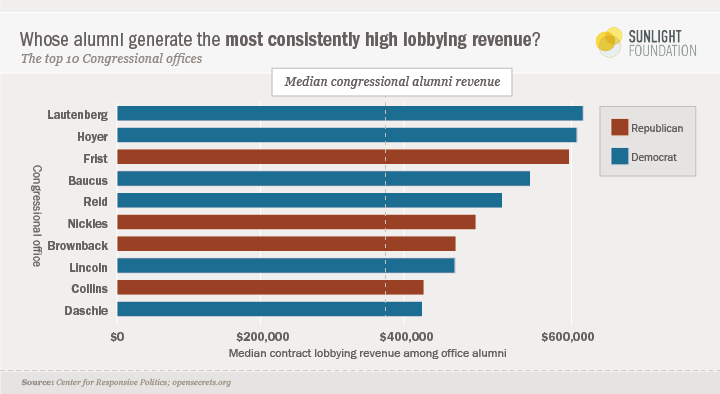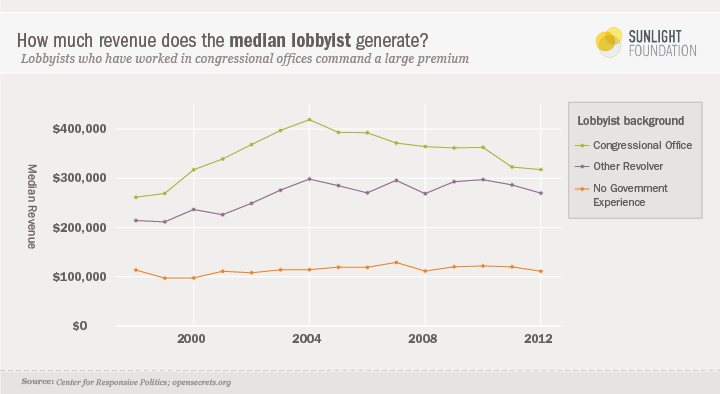Whose former staffers make the most as lobbyists? Lott, Frist, Hoyer top the list
In 2007, then Senate Minority Whip Trent Lott, R-Miss., abruptly announced his resignation — mid-term — to become a lobbyist. In doing so, he joined many of his former employees.
Former Lott staffers loom large in the lobbying world. We count 25 different Lott alumni working as contract firm lobbyists between 1998 and 2012, generating a total of $91 million in lobbying revenue – the highest of any former member of Congress in revenue, and second only to the late Republican-turned-Democrat Sen. Arlen Specter, Pa., in terms of former employees.1
We find 27 contract lobbyists who list Specter as a former boss between 1998 and 2012, though collectively former Specter lobbyists generated less revenue: $46 million.
Figure 1, below, lists the top 10 members of Congress by total revenue that their former staff have gone on to generate as lobbyists between 1998 and 2012.

Lott tops the list at $91.1 million, followed by his long-time Republican Senate colleague, Bill Frist, Tenn., who served as Majority Leader from 2003 to 2007, at $76.6 million. Lott and Frist are well ahead of the competition. In third place are the 13 alumni of Rep. Steny Hoyer, D-Md., the long-time number two among House Democrats. Rounding out the top five are former Sen. Kay Bailey Hutchison, R-Texas, at $54.3 million and former Sen. Edward Kennedy, D-Mass., at $54.2 million. Notably, nine of the top 10 are senators, which makes sense since senators have larger offices. Six of the 10 are Democrats.
| Office | Total | Median | Unique Alums | Lobbyist-Years (obvs) | Million Club Percentage | Percentage Earning More than MOC |
|---|---|---|---|---|---|---|
|
Lott |
$91,050,570 |
$418,268 |
25 |
165 |
16% |
72% |
|
Frist |
$76,609,204 |
$630,619 |
20 |
128 |
10% |
84% |
|
Hoyer |
$56,225,255 |
$641,095 |
13 |
92 |
11% |
83% |
|
Hutchison |
$54,315,340 |
$334,085 |
19 |
130 |
10% |
69% |
|
Kennedy |
$54,179,403 |
$314,510 |
21 |
122 |
7% |
73% |
|
Baucus |
$48,273,080 |
$576,275 |
12 |
93 |
8% |
80% |
|
Specter |
$46,314,373 |
$259,107 |
27 |
123 |
7% |
60% |
|
Feinstein |
$44,697,595 |
$364,433 |
15 |
95 |
6% |
80% |
|
Dorgan |
$43,714,241 |
$298,770 |
15 |
100 |
12% |
75% |
|
Breaux |
$43,443,141 |
$415,433 |
15 |
94 |
10% |
81% |
If we measure offices by the median annual revenue their alumni generate during their time as lobbyists, the list shifts around a little. We limit the list only to offices with at least 10 different lobbyists, to assure that the median is representative.

Here, former Sen. Frank Lautenberg, D-N.J., tops the list. His 13 alumni who became lobbyists generated a median revenue of $650,000 for the years in which they lobbied. He is followed closely by Hoyer (13 lobbyists, median revenue of $641,000) and Frist (20 lobbyists, median revenue of $630,000). Interestingly, when we measure member alumni by median revenue, Lott drops off the top 10; he actually falls to 12th place. His alumni generated a median revenue of $418,268, putting him two behind his old colleague Tom Daschle, D-S.D., who is also well-known for his activity in the lobbying industry.
| Office | Total | Median | Unique Alums | Lobbyist-Years (obvs) | Million Club Percentage | Percentage Earning More than MOC |
|---|---|---|---|---|---|---|
|
Lautenberg |
$30,542,347 |
$649,887 |
13 |
55 |
16% |
67% |
|
Hoyer |
$56,225,255 |
$641,095 |
13 |
92 |
11% |
83% |
|
Frist |
$76,609,204 |
$630,619 |
20 |
128 |
10% |
84% |
|
Baucus |
$48,273,080 |
$576,275 |
12 |
93 |
8% |
80% |
|
Reid |
$40,587,065 |
$537,083 |
14 |
68 |
24% |
69% |
|
Nickles |
$41,498,885 |
$500,242 |
10 |
72 |
10% |
81% |
|
Brownback |
$24,962,722 |
$472,371 |
11 |
60 |
0% |
78% |
|
Lincoln |
$27,764,769 |
$471,057 |
14 |
58 |
2% |
79% |
|
Collins |
$18,611,529 |
$427,667 |
10 |
46 |
0% |
78% |
|
Daschle |
$21,348,848 |
$425,754 |
10 |
53 |
0% |
77% |
|
Warner |
$32,607,788 |
$419,433 |
12 |
65 |
11% |
71% |
Though we can slice the data any number of ways to estimate which offices generate the most revenue, the basic observation will come as no surprise to anyone who understands lobbying: Working for a long-serving senator — especially one in a key leadership position — is a very good stepping stone to a lucrative career in lobbying.
Finally, we can also observe that revolving door lobbyists who list a specific congressional office in their lobbying disclosure forms are consistently associated with more revenue than other revolving door lobbyists who don’t list a specific congressional office. Between 1998 and 2012, the median revolving lobbyist listing an office earned $87,680 more than the median revolver who didn’t. This difference peaked in 2006, with a difference just more than $122,000. Both groups, however, earn substantially more than active contract lobbyists who don’t list any government experience.

What is clear is that congressional experience pays off, especially working for a top senator. If you want to get extremely rich as a lobbyist (high six figures), find a powerful Senate office to work for first. And if you just want to get somewhat rich (low-to-mid six figures), well, most congressional offices appear to do fine. Congressional experience is increasingly rewarded on K Street.

